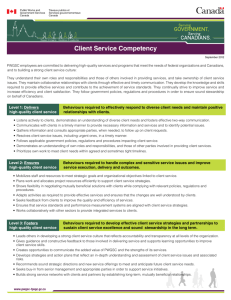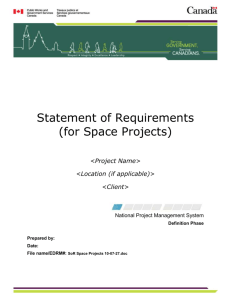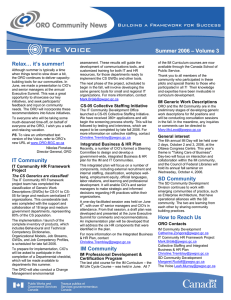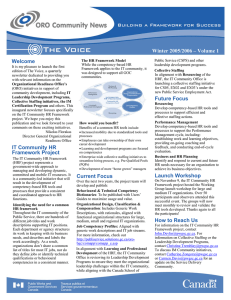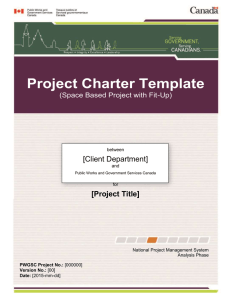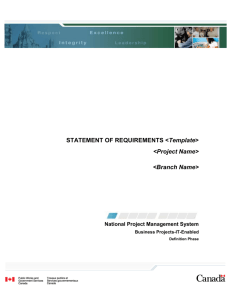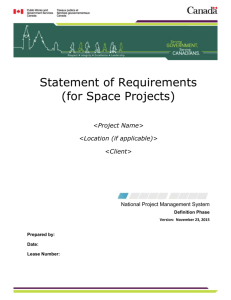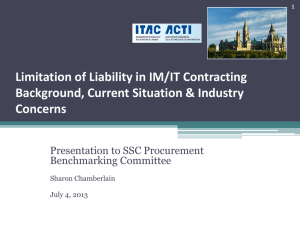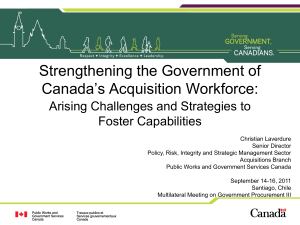REPORT ON PLANS AND PRIORITIES pwgsc.gc.ca
advertisement
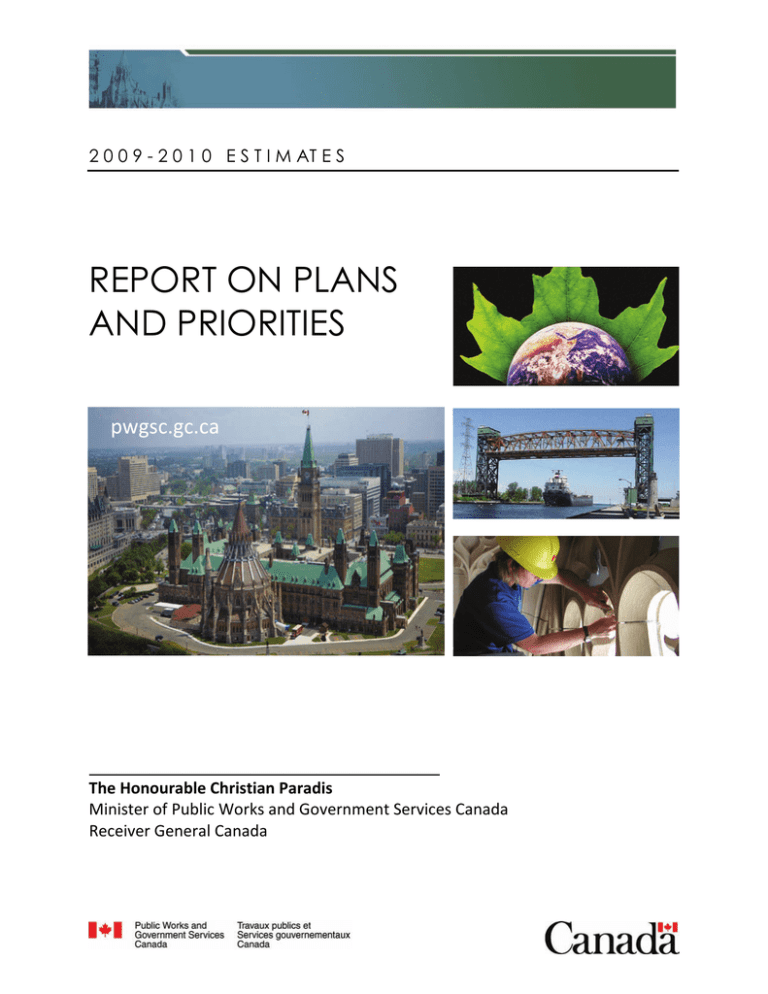
2 0 0 9 - 2 0 1 0 E S T I M AT E S REPORT ON PLANS AND PRIORITIES pwgsc.gc.ca The Honourable Christian Paradis Minister of Public Works and Government Services Canada Receiver General Canada TABLE OF CONTENTS MINISTER’S MESSAGE ........................................................................................................................... iii SECTION 1 – DEPARTMENTAL OVERVIEW ...................................................................................... 1 1.1 Summary Information .................................................................................................................... 1 1.2 Planning Summary .......................................................................................................................... 3 SECTION 2 – ANALYSIS OF PROGRAM ACTIVITIES ....................................................................... 9 2.1 Strategic Outcome ............................................................................................................................ 9 2.2 Program Activities ............................................................................................................................ 9 2.2.1 Program Activity: Acquisitions ................................................................................................ 9 2.2.2 Program Activity: Accommodation and Real Property Assets Management ................. 11 2.2.3 Program Activity: Receiver General for Canada ................................................................. 12 2.2.4 Program Activity: Information Technology Infrastructure Services ................................ 13 2.2.5 Program Activity: Federal Pay and Pension Administration ............................................ 14 2.2.6 Program Activity: Linguistic Management and Services ................................................... 15 2.2.7 Program Activity: Specialized Programs and Services ....................................................... 16 2.2.8 Program Activity: Procurement Ombudsman ..................................................................... 18 2.2.9 Program Activity: Internal Services ....................................................................................... 19 SECTION 3 – SUPPLEMENTARY INFORMATION .......................................................................... 21 3.1 Financial Highlights ....................................................................................................................... 21 3.2 List of Supplementary Information Tables ................................................................................. 22 2009-2010 Estimates – Report on Plans and Priorities i ii Public Works and Government Services Canada MINISTER’S MESSAGE I am pleased to present Public Works and Government Services Canada’s (PWGSC) Report on Plans and Priorities for 2009‐2010. As the largest provider of common, central and shared services to other departments and agencies, PWGSC is committed to helping streamline the way the Government of Canada does business. Sound management is key to Canada’s economic and fiscal future. Budget 2009 includes commitments to make significant investments in building and renewing Canada‐wide federal public infrastructure over the next two years. Our department will be accelerating its plans to repair and restore federal buildings and bridges and to enhance the accessibility of federal buildings. We will be called upon to support the activities of our colleague departments and will have the opportunity to work with other levels of government to coordinate the delivery of these activities and demonstrate our leadership in our core areas of expertise. As part of Canada’s Economic Action Plan, we are planning for the future of Québec City’s historic drill hall—the Manège Militaire, and preserving the architectural integrity and historic significance of our heritage buildings in the Parliamentary Precinct. As well, the modernization and streamlining of our real property processes will incorporate environmentally responsible management practices to ensure safe, healthy and affordable accommodations to those who serve Canadians. Small and medium‐sized enterprises and Aboriginal businesses will continue to benefit from our procurement renewal efforts. By simplifying how the government purchases goods and services, we are reducing the cost of doing business for suppliers. At the same time, we are ensuring suppliers have open and fair access to government contracting opportunities while achieving best value for Canadians. We will also continue to implement simpler and streamlined procurement processes to acquire urgently needed goods and services for the Canadian Forces. In addition, my department is modernizing our pension systems in order to generate savings and to improve how we deliver these services to current and retired public servants. Delivering information technology products, services and programs more effectively and efficiently is also a key priority for PWGSC, and we remain committed to working closely with other departments to reduce the government’s environmental footprint. All of our activities will take into consideration the current economic uncertainty and challenges. We are redoubling our efforts to engage our stakeholders so that their views and concerns are considered in the development and review of our programs and services. I am proud of our progress to make government more effective. And I remain fully committed to leading this department in its efforts to deliver high‐quality services and programs that meet the needs of federal organizations and ensure sound stewardship on behalf of all Canadians. The Honourable Christian Paradis 2009-2010 Estimates – Report on Plans and Priorities iii iv Public Works and Government Services Canada SECTION 1 – DEPARTMENTAL OVERVIEW 1.1 Summary Information Raison d’être Public Works and Government Services Canada (PWGSC) plays an important role in the daily operations of government. We are the government’s principal banker, accountant, central purchasing agent, translation authority, real property manager and enabler of access to government services online. Our vision is to excel in government operations by delivering high‐quality services and programs that meet the needs of federal organizations and ensure sound stewardship on behalf of Canadians. Responsibilities The department was originally founded in 1841 and was instrumental in the building of our nation’s canals, roads and bridges, the Houses of Parliament, post offices, and federal buildings across the country. Today, we have evolved into a sophisticated operational arm of government that employs nearly 14,000 staff working in the National Capital and five regional offices in Halifax, Montreal, Toronto, Edmonton, and Vancouver. The Department of Public Works and Government Services Act, passed in 1996, established the department and set out the legal authorities for PWGSC’s services. Specifically, the Act established PWGSC as a common service agency providing government departments, boards and agencies with services in support of their programs, including: • • • • Acquisition of goods and services; Office accommodation and facilities; Architectural and engineering services; Construction, maintenance and repair of public works and federal real property; and 2009-2010 Estimates – Report on Plans and Priorities • Provision of translation, information technology, telecommunications, industrial security and consulting and audit services. The Act also specifies that the Minister of PWGSC is the Receiver General for Canada and has the authority for the administration of services related to benefits, superannuation and pension plans and disbursement of pay to federal employees. Our goal is to run our business in a way that strengthens accountability and adds value to our clients. In doing so, PWGSC: • Provides accommodation to parliamentarians and to more than 241,000 public servants in 1,800 locations across Canada; • Injects more than $14 billion annually into the Canadian economy through government procurement; • Issues nearly 13.5 million federal pay and pension payments to Canadians; • Helps more than 18,000 small and medium‐ sized enterprises do business with the federal government; • Provides translation and interpretation services annually for more than 2,000 sessions of Parliament and 1.5 million pages of translation for other federal organizations; and • Handles more than $1.6 trillion in cash flow transactions as the Receiver General for Canada. 2009-2010 Program Activity Architecture In 2008, we improved our reporting to Parliament by consolidating and streamlining our Program Activity Architecture (PAA). This was done to better reflect PWGSC’s commitment to be a dynamic, results‐based organization which is focused on providing tangible benefits to Canadians. 1 structures, tools and processes to drive quality and efficiency into all facets of our business. Guided by the new strategic outcome, we are building on international best practices and taking concrete steps to improve the use of different planning, performance measurement and reporting tools to enhance the organizational capacity and management practices of our department. The new PAA, as approved by Treasury Board in 2008, consolidates the number of program activities from twenty‐six to nine, and establishes our strategic outcome as follows: High‐quality, central programs and services that ensure sound stewardship on behalf of Canadians and meet the program needs of federal institutions. Our new PAA allows us to pursue our mandate more effectively, enabling us to place increased emphasis on improving our management The table below showcases PWGSC’s complete framework of program activities and program sub‐activities, which contribute to the department’s strategic outcome. Program Activity Architecture Program Activities Program Sub-Activities Acquisitions Procurement Services Customized/Unique Procurement Services Strategic Acquisition Support Services Accommodation and Real Property Assets Management Federal Accommodation Federal Holdings Professional and Technical Services Disposition Incentives Payments in Lieu of Taxes Parliamentary Precinct Receiver General for Canada Stewardship of Public Money and Accounts of Canada Receiver General Services Information Technology Infrastructure Services Distributed Computing Services Data Centre Services Telecommunications Services Information Technology Security Services Federal Pay and Pension Administration Pay Pension Linguistic Management and Services Management of Translation Function Terminology Standardization Program Translation and Other Linguistic Services Translation and Interpretation to Parliament Conference Interpretation Specialized Programs and Services Industrial Security Program Greening of Government Operations Sydney Tar Ponds and Coke Ovens Remediation Project Government Information Services Government Consulting Services Audit Services Canada Seized Property Canadian General Standards Board Forensic Accounting Crown Assets Distribution Shared Travel Services Initiative Marine Inspection and Technical Services Document Imaging Services Shared Services Integration Procurement Ombudsman Review of Procurement Practices Supplier Complaints Internal Services 2 Public Works and Government Services Canada 1.2 Planning Summary Financial and Human Resources resources Full‐Time Equivalents (FTEs) for the next three fiscal years (2009‐2010 to 2011‐2012). The table below provides a summary of PWGSC’s total planned spending and human Financial and Human Resources Summary Financial Resources (in millions of dollars) Gross Expenditures Less Respendable Revenue Net Expenditures 2009-2010 Planned Spending 2010-2011 5,922.0 3,045.7 2,876.3 5,437.5 2,858.4 2,579.1 2011-2012 4,897.0 2,709.7 2,187.3 Human Resources Full-Time Equivalents (FTEs) 13,928 Planned Spending by Program Activity 13,855 13,866 Canada’s whole‐of‐government reporting framework. The table below outlines PWGSC’s net forecasted spending for 2008‐2009 and the net planned spending, by program activity, from 2009‐2010 to 2011‐2012. Federal departments and agencies are supported by PWGSC’s strategic outcome and program activities, which are aligned to the Government Affairs’ spending area of the Government of Forecast and Planned Spending Forecast Spending 2008-2009 Program Activity (in millions of dollars) Planned Spending 2009-2010 2010-2011 2011-2012 Acquisitions 118.7 110.4 110.3 110.2 Accommodation and Real Property Assets Management 1,767.8 2,157.3 1,884.0 1,503.0 Receiver General for Canada 126.1 131.2 128.1 127.6 Information Technology Infrastructure Services 19.4 14.4 3.9 1.5 Federal Pay and Pension Administration 36.4 31.6 31.5 27.5 Linguistic Management and Services 72.6 70.2 66.4 65.3 Specialized Programs and Services 89.7 87.3 81.7 79.8 Procurement Ombudsman 4.4 4.3 4.3 4.3 Internal Services 286.9 269.6 268.9 268.1 Total for strategic outcome 2,522.0 2,876.3 2,579.1 2,187.3 Note: Includes intradepartmental revenues and expenditures of $241.5 million for 2008-2009, $229.7 million for 2009-2010, $254.8 million for 2010-2011, and $314.8 million for 2011-2012 for a nil bottom line impact. Forecast spending for 2008-2009 includes $7.6 million for volume and inflationary pressures on non-discretionary charges for federal accommodation and holdings and $6.1 million for Translation and Interpretation to Parliament. Planned spending includes $457.1 million announced in the Budget 2009 for the Accelerated Infrastructure Program ($237.6 million for 2009-2010 and $219.5 million for 2010-2011). The nine program activities of our PAA contribute to PWGSC’s strategic outcome. The table below describes the performance indicator and target for PWGSC’s single strategic outcome. This is a composite of the performance indicators and targets of various program activities described in Section 2 of this report. Strategic Outcome Performance Indicator Target Achievement Date High-quality, central programs and services that ensure sound stewardship on behalf of Canadians and meet the program needs of federal institutions. Percentage of programs and services that meet their expected results, including service levels and published standards. 95% March 31, 2010. 2009-2010 Estimates – Report on Plans and Priorities 3 Contribution of Priorities to Strategic Outcome The government established “Making Government More Effective” as a priority in the November 2008 Speech from the Throne. PWGSC is well‐aligned to support this priority and to advance our department’s strategic outcome. We will do this by taking a multi‐pronged approach to achieve our operational and management objectives in the upcoming year. We will realign and refocus our services through initiatives such as real property modernization, procurement renewal, and pay and pension modernization. In addition, we will improve the quality and value of our services by working closely with our clients and partners, including suppliers, to identify, develop and implement new and innovative ways to improve our service offerings. Finally, we will continue to strengthen our organizational capacity and improve the fundamentals of our business. Our operating environment is strongly influenced by national and international developments. Within the government, these trends include preference for cost‐effective models that provide smarter, faster service delivery, in a way that ensures Canadians receive the best possible value for their tax dollars. Our plans and priorities are strongly influenced by these trends. As listed below, fourteen key operational and management priorities have been identified for 2009‐2010. Strategic Outcome: High-quality, central programs and services that ensure sound stewardship on behalf of Canadians and meet the program needs of federal institutions. OPERATIONAL Type PRIORITIES Military and Major Ongoing Procurement Program Activity Acquisitions Procurement Renewal Ongoing Acquisitions Real Property Modernization Ongoing Accommodation and Real Property Assets Management Greening of Government Ongoing Specialized Programs and Services Parliamentary Precinct Project (Long-Term Vision and Plan) Ongoing Accommodation and Real Property Assets Management 4 Description Improving the efficiency of military and major procurements has been, and continues to be, a significant priority for the department. In collaboration with the departments of National Defence, Fisheries and Oceans, Industry Canada and the Treasury Board Secretariat, PWGSC will work to further streamline acquisitions processes and reduce timelines for military and major procurements. Efforts will also be deployed to maximize benefits for Canada from the planned large investments in the Canadian Forces and the Coast Guard while engaging and working with industry. In consultation with key stakeholders, PWGSC is using best practices to modernize and streamline our procurement practices, supported by improved self-serve opportunities via supplier and client e-portals, sophisticated delegation mechanisms and robust benchmarks, service standards and measures. We intend to move up the value-chain, to optimize existing cadres of expertise for higher value work, while revitalizing the acquisitions business model to support procurement processes that are efficient, effective and as responsive as possible to our stakeholders while providing best value for the Canadian taxpayer. PWGSC is modernizing our real property business by employing a systematic approach to transforming key business elements: portfolio management and asset integrity, improved client relationship management, enhanced business processes, systems and service delivery mechanisms, and strengthened people and stakeholder partnerships. The objectives are to increase efficiencies, improve the services we provide to clients, and provide better value for money for taxpayers. PWGSC is committed to working closely with other government departments to improve the environmental performance of the federal government’s operations in the areas of land, buildings, business and movement. We will work, in collaboration with partner departments, to establish governmentwide operational priorities, accountabilities, targets, timelines and reporting requirements to support the government’s environmental agenda. As the custodian of the buildings in the Parliamentary Precinct, PWGSC is investing to protect their architectural integrity through the Long-Term Vision and Plan (LTVP): a blueprint for renovations and new construction to meet accommodation requirements identified by the Senate, House of Commons, and the Library of Parliament. The LTVP establishes the renovation of the core buildings (the West, Centre and East Blocks) as the first priority. Public Works and Government Services Canada Information Technology Shared Services Ongoing Information Technology Infrastructure Services Pension Administration Transformation Ongoing Federal Pay and Pension Administration Pay Administration Transformation Ongoing Federal Pay and Pension Administration Translation Renewal Ongoing Linguistic Management and Services Industrial Security Ongoing Program MANAGEMENT PRIORITIES Workforce for the Future Type Specialized Programs and Services Program Activity Ongoing Internal Services System Renewal Support to Fundamentals Agenda Ongoing Internal Services Organizational Excellence New Internal Services Risk Management New Internal Services PWGSC is committed to delivering a consistent set of government-wide information technology infrastructure products and services to enable government departments to deliver on their priorities. In partnership with other departments, PWGSC is leading a government-wide information technology (IT) transformation as part of the IT Shared Services initiative, including: shared enterprise network, data centre consolidation, IT security, and managed desktop services. Our pension administration systems are outdated, inefficient and difficult to maintain. In order to ensure sustainability and consistent service delivery to plan members, and improved service levels to employers, employees and pensioners, PWGSC is modernizing our pension administration system and process infrastructure. During the next three and a half years, we will reengineer business processes, replace existing systems with modern software products, and centralize service delivery within PWGSC. PWGSC will continue to examine how we can modernize the government ’s pay administration systems and services. Our goal is to transform the government’s pay administration by increasing automation and self-service while reducing the need for assistance from departmental compensation advisors. PWGSC is developing the capacity to meet growing demand for translation and interpretation services in official languages, Aboriginal languages and in those foreign languages that are needed in military, diplomatic and intelligence areas. PWGSC will help ensure the security of supply of qualified professionals to meet the needs of Parliament and federal institutions. PWGSC’s Industrial Security Program contributes to the government’s national security agenda and safeguards Canadian and foreign governments’ sensitive information and assets entrusted to the private sector, companies or individuals, when under government contract. We ensure that controlled goods are protected against unauthorized possession, examination or transfer when in custody of the private sector. By working closely with our partners, we will continue to identify solutions for a more streamlined and consistent process for both government and the private sector. Description PWGSC expects that a significant number of our employees will retire in the next few years. To meet this challenge, our human resources renewal agenda focuses on employee recruitment, retention and development. We will increase capacity and new skill sets in areas like strategic management and information technology. We will emphasize change management, change leadership and continue to implement the Public Service Employee Survey Action Plan. To strengthen PWGSC’s management fundamentals and enhance the integrity and transparency of our decision-making, we will improve our business processes and introduce new systems and technologies. This will include stabilizing our investments with SIGMA - our financial management system - and exploring the implementation of systems-based solutions to improve the management of our human resources, internal controls, financial information reporting, connectivity among business systems and other executive decision-support processes. Our goal is to incorporate best practices and innovations in technology and systems to increase the range of our executive oversight, prudence, probity and sound management. PWGSC projects are underway to redesign key processes to consistently produce and deliver programs and services that meet or exceed client requirements; comply with legislative, regulatory and policy requirements; and respect established standards. Quality improvements and enhanced management practices will result in processes, products, programs and services that are recognized for their excellence and efficiency and support business decisions. PWGSC has developed management tools and mechanisms to identify, monitor, report and manage risks. The Corporate Risk Profile is updated annually to identify key corporate-level risks and internal risk mitigation strategies related to departmental initiatives. PWGSC will focus on effectively treating residual vulnerabilities and integrating sound risk management practices throughout the department’s operations. 2009-2010 Estimates – Report on Plans and Priorities 5 Risk Analysis PWGSC integrates risk management principles and practices into our strategic and operational decision‐making. This helps us minimize the negative impacts of uncontrolled events and maximize opportunities to improve our service delivery and add value to the operations of government. PWGSC faces a number of external and internal risks for 2009‐2010. The dominant external risks centre around the growing operational demands associated with major project initiatives such as military procurement, real property infrastructure, and information technology. In addition, as government revenues decline due to the downturn in the economy, PWGSC will be faced with significant pressures to find greater efficiencies and cost savings, beyond those already achieved in recent years. While external risks will dominate PWGSC’s operational requirements, internal risks are equally important for our department’s long‐ term viability. PWGSC completed, in 2008, a Corporate Risk Profile which identified a number of internal risks, including: • Human resources capacity, skills shortages and competency gaps; • Risk averse public sector culture and its effect on departmental processes and practices; • Lack of clarity in roles and responsibilities between PWGSC and key stakeholders and sustainability of our business model of funding and service provision for client departments; • Ability of the legacy information management and information technology infrastructure to meet the modern needs of PWGSC and our key stakeholders; and, • Demands related to organizational change required by initiatives such as procurement renewal, changes to the real property business model, and pension/pay modernization. 6 PWGSC has developed appropriate risk mitigation strategies to manage these risks. Our Corporate Integrated Risk Management Framework is being revised to address the complex operating environment of our business. We have instituted specific policies and guidelines for assessing risk related to acquisitions and national projects for real property. We are also adopting best practices in risk management as developed by the International Standards Organization. In 2008, PWGSC created the Departmental Oversight Branch to provide expertise in risk, quality and conflict management; fairness monitoring; internal disclosure; forensic accounting; audit and evaluation; and special investigations so that the department’s operations are conducted in a way that ensures probity and transparency. Expenditure Profile PWGSC’s planned spending is strongly influenced by national and international developments, and by trends within the government community. External to government, a downturn in the economy, international commitments such as Afghanistan and sustainable development challenges will influence PWGSC’s services and spending. Within government, trends influencing the plans and priorities of PWGSC include the growing preference for government‐wide service models, the need to ensure that Canadians receive the best possible value for their tax dollars, and the need to demonstrate transparency and accountability in all that we do. PWGSC has also been undergoing a significant business renewal agenda, aimed at finding innovative ways to deliver services smarter, faster and at reduced cost, while demonstrating improved accountability and results. As with any large‐scale business renewal, there are major challenges in continuing to deliver ongoing operations while implementing modernized approaches and processes. The positive consequences of business renewal are beginning to be reflected in our planned spending trend from 2005‐2006 to 2011‐2012, as noted below. Public Works and Government Services Canada PWGSC Spending Trend Note: 2009-2010 and future years represents best estimates of departmental initiatives. Planned spending includes the known funding approved in the annual budget process plus the recent 2009 Budget announcement for the Accelerated Infrastructure Program for 2009-2010 and 2010-2011. Additional information may be found on the departmental website at: http://www.tbssct.gc.ca/rpp/st-ts-eng.asp. Voted and Statutory Items For the 2009‐2010 fiscal year, PWGSC plans to spend $2,876.3 million to meet the expected results of our program activities and contribute to our strategic outcome. The table below shows how Parliament approved PWGSC’s resources. The variance of $488.8 million, between 2009‐ 2010 Planned Spending and the Main Estimates, relates to earmarked items and Budget 2009 announcements for which funds will be spent on specific expenditures. (in millions of dollars) Vote or Statutory Item Main Estimates 2008-2009 Vote or Statutory Wording 1 5 10 (S) Operating expenditures Capital expenditures Grants and contributions Minister of Public Works and Government Services - Salary and motor car allowance (S) Contributions to employee benefit plans (S) Real Property Disposition Revolving Fund (S) Optional Services Revolving Fund (S) Consulting and Audit Canada Revolving Fund (S) Translation Bureau Revolving Fund (S) Payment in lieu of taxes to municipalities and other taxing authorities (S) Real Property Services Revolving Fund (S) Telecommunications and Informatics Common Services Revolving Fund (S) Defence Production Revolving Fund DEPARTMENT TOTAL Main Estimates 2009-2010 1,975.9 290.9 0.1 1,947.5 349.1 0.1 79.7 (5.5) 2.0 2,343.1 78.4 (5.2) (3.6) 5.1 10.0 6.1 2,387.5 PAA Crosswalk The crosswalk below displays the redistribution of 2008‐2009 forecast spending between PWGSCʹs old and new PAAs. As PWGSC depends heavily on client revenue, the figures 2009-2010 Estimates – Report on Plans and Priorities represent gross expenditures. Pursuant to TBS reporting guidelines, revenue by program activity has been used to arrive at net expenditures reported in other financial tables. 7 PAA Crosswalk: 2008-2009 Forecast Spending 2008-2009 Program Activities Acquisition Services Optional Services Revolving Fund Defence Production Revolving Fund Federal Accommodation and Holdings Real Property Services Revolving Fund Real Property Disposition Revolving Fund Information Technology Infrastructure Services Telecommunications and Informatics Common Services Revolving Fund Linguistic Services Translation Bureau Revolving Fund Consulting and Audit Canada Revolving Fund Information Services Receiver General Services Public Service Compensation Services Greening of Government Operations Services Acquisition Stewardship Real Property Stewardship Information Technology Infrastructure Stewardship Business Integration Performance Management Linguistic Stewardship Information Stewardship Receiver General Stewardship Public Service Pay Stewardship Public Services Pension Stewardship Greening of Government Operations Stewardship Internal Services 110.0 104.4 Total Gross Expenditures 253.2 3,660.1 141.2 435.3 149.8 271.1 Total Respendable Revenue 134.5 1,892.3 15.1 415.9 113.4 198.5 31.6 Internal Services Procurement Ombudsman Specialized Programs and Services (in millions of dollars) Linguistic Management and Services Federal Pay and Pension Administration Receiver General for Canada Information Technology Infrastructure Services Accommodation and Real Property Assets Management Program Activities Acquisitions 2009-2010 Program Activities 17.4 Total 159.0 104.4 0.0 2,646.1 2,646.1 979.9 979.9 3.0 3.0 226.4 83.7 201.0 310.1 201.0 63.6 205.1 6.4 63.6 205.1 43.4 43.4 79.8 1.8 79.8 8.2 3.6 26.9 26.9 3.6 38.8 31.1 7.9 32.2 38.8 31.1 40.1 0.0 2.4 2.4 15.3 134.8 15.3 134.8 32.9 32.9 113.3 113.3 3.2 3.2 4.4 306.8 311.2 202.0 4.4 440.1 5,557.2 112.3 0.0 153.2 3,035.2 Total Net Expenditures 118.7 1,767.8 126.1 19.4 36.4 72.6 89.7 4.4 286.9 2,522.0 Note: PWGSC has simplified the PAA by aligning and integrating revolving funds within our program activities. For details, see Table 13 on the deparmental website at: http://www.tbs-sct.gc.ca/rpp/st-ts-eng.asp. 8 Public Works and Government Services Canada SECTION 2 – ANALYSIS OF PROGRAM ACTIVITIES 2.1 Strategic Outcome arrangements. The role of PWGSC in this area is to provide timely, value‐added acquisitions and related common services to Canadians and the federal government. The PWGSC strategic outcome is to achieve: High‐quality, central programs and services that ensure sound stewardship on behalf of Canadians and meet the program needs of federal institutions. Benefits for Canadians 2.2 Program Activities The following section describes PWGSC’s nine program activities and the expected results, performance indicators and targets for each program activity. It also includes an overview of the financial and human resources, planning highlights, and benefits that the program activity aims to deliver to Canadians. Additional information is available on our departmental website at www.pwgsc‐tpsgc.gc.ca. 2.2.1 Program Activity: Acquisitions This program activity shows PWGSC as the government’s primary procurement service provider offering federal organizations a broad base of procurement solutions such as specialized contracts, standing offers and supply On average, PWGSC facilitates the procurement of goods and services, at best value, worth approximately $14 billion annually with some 60,000 procurement‐related transactions. Our acquisitions program activity provides economic stimulus by identifying and removing barriers to Canadian small and medium‐sized enterprises, ensuring the participation of Aboriginal‐owned businesses, and by partnering with Industry Canada to implement Industrial and Regional Benefits programs. Furthermore, environmental performance considerations throughout the procurement process contribute significantly to the reduction of environmental impacts of government operations and to more effective environmental stewardship overall. Finally, PWGSC supports Canada’s military operations in Canada and overseas by providing timely procurement expertise and tools to ensure that military personnel and troops receive the equipment they require to be effective in their missions. Through our procurement strategy, PWGSC is contributing to the government’s agenda to be service‐focused and results‐ oriented to benefit Canadians. Acquisitions: Financial and Human Resources Financial Resources (in millions of dollars) Gross Expenditures Less Respendable Revenue Net Expenditures 2009-2010 Planned Spending 2010-2011 2011-2012 242.3 131.9 110.4 243.0 132.7 110.3 243.6 133.4 110.2 Human Resources Full-Time Equivalents (FTEs) 2,114 2009-2010 Estimates – Report on Plans and Priorities 2,116 2,115 9 Expected Results Performance Indicators Targets Achievement Date 85% or 10% above March 31, 2012* Percentage of federal Federal organizations receive baseline* organizations satisfied with responsive and cost effective timeliness, quality and value of access to goods and services acquisition services provided. that meet specifications, are timely, and provide value for money to support the delivery of their programs. 16,000 March 31, 2010 Number of individuals and small Prudent use of federal and medium enterprise resources, effective and representatives directly assisted efficient acquisition practices, and fair access to government by Office of Small and Medium Enterprises. business. Percentage increase in standing 5% March 31, 2010 Federal organizations are offer and supply arrangement provided with a broad base of usage by federal organizations. procurement solutions including contracts, standing offers, supply arrangements and procurement tools that are timely and provide value for money to support the delivery of their programs. * Note: A client satisfaction survey will be conducted in fiscal year 2009-2010 to establish the baseline. Our notional target would be 85% but may require adjustment once baseline is established. As well, implementation of the procurement renewal strategy with our stakeholders, clients and suppliers will directly support the three-year achievement of this target. Planning Highlights • In collaboration with key stakeholders at the Department of National Defence, Industry Canada, and the Treasury Board Secretariat, PWGSC will improve efficiency and transparency of military procurement, and ensure that military equipment and services are delivered in a timely manner and meet the needs of Canadian soldiers. • In partnership with the interdepartmental Assistant Deputy Minister Advisory Committee on Procurement Renewal, PWGSC will develop a Procurement Renewal Strategy to modernize the government’s acquisition rules and tools to make procurement more efficient, simpler, and cost‐effective, while respecting legal, regulatory, and socio‐economic objectives. • PWGSC will increase e‐procurement capability to respond to the needs of suppliers and departments via the creation of an e‐portal that will make available pre‐ competed procurement instruments and valuable information for transacting business. • Commodity Management is an industry best practice where expert buyers observe marketplace trends and establish the best plan for buying, using, and disposing of that 10 item for the government. By continuing with this work, PWGSC will lower the government’s cost of ownership for assets, and obtain the best value for taxpayers by grouping purchases to take advantage of the government’s buying power. • Through our Office of Small and Medium Enterprises, PWGSC will strengthen the management of relationships with suppliers by ensuring that suppliers, as a key source of Canadian employment, are better able to serve the needs of departments and Canadians. We will do this by extending our outreach program, expanding our recommendations to simplify and streamline the procurement process, creating greater understanding of the Government of Canada as a client and the marketplace in which it operates, and introducing innovations to enhance the interaction between the government and its suppliers. Public Works and Government Services Canada 2.2.2 Program Activity: Accommodation and Real Property Assets Management This program activity is about how PWGSC provides departments and agencies with office and common use accommodation and acts as stewards for various public works such as buildings, bridges and dams, and national treasures such as the Parliamentary Precinct and other heritage assets across Canada. PWGSC also provides other federal departments and agencies with expert professional and technical real property services. Benefits for Canadians PWGSC offers a diverse portfolio of real estate for accommodating some 241,000 federal public servants in more than 1,800 locations, contributing directly to programs and services delivered to Canadians across the country. We address the environmental challenges Canada faces by introducing sustainable development practices into all new federal building projects. As announced in Budget 2009, PWGSC will improve the asset integrity of our real estate portfolio through the rehabilitation of federally owned infrastructure. We will achieve this objective while ensuring tax payers receive the expected value for money for these investments. PWGSC contributes to local communities across Canada through our Payments in Lieu of Taxes (PILT) Program. In 2008‐2009, we will distribute $468.6 million to 1,300 taxing authorities, where federal property is located. This will include municipalities, provinces, school boards, local services boards and First Nations. PWGSC also ensures that Parliamentarians and their staff can exercise the democratic responsibilities of Parliament by preserving the Parliamentary Precinct’s architectural integrity and providing functional accommodations. Accommodation and Real Property Assets Management: Financial and Human Resources Financial Resources (in millions of dollars) Gross Expenditures Less Respendable Revenue Net Expenditures 2009-2010 Planned Spending 2010-2011 4,078.5 1,921.2 2,157.3 3,785.3 1,901.3 1,884.0 2011-2012 3,371.6 1,868.6 1,503.0 Human Resources Full-Time Equivalents (FTEs) 3,671 3,672 3,671 Note: The decrease in expenditures from 2009-2010 to subsequent years is mainly due to annual funding adjustment for quasistatutory items (price protected items) which were not approved by Treasury Board. Planned spending includes $457.1 million announced in the Budget 2009 for the Accelerated Infrastructure Program ($237.6 million for 2009-2010 and $219.5 million for 2010-2011). Expected Results Performance Indicators Targets Achievement Date Federal organizations have safe, healthy and affordable facilities that support the effective delivery of their programs and services, through prudent investment and management of federal real property assets in the custody of PWGSC. Number of critical accommodationrelated health and safety incidents per year. Relative difference between PWGSC operating expenses and the average operating expenses indexed by the Canadian Building Owner and Managers Association (BOMA-Canada). Percentage of federal organizations satisfied with real property services. <5 March 31, 2010 <15% March 31, 2010 85% March 31, 2012 Federal organizations receive responsive and cost-effective real property services in support of the effective delivery of their programs and services. 2009-2010 Estimates – Report on Plans and Priorities 11 Planning Highlights • PWGSC will implement a modern corporate real estate organization by developing tools and business processes to enhance our business performance. • PWGSC will continue to develop investment tools and processes to improve portfolio management and asset integrity. • PWGSC’s ability to deliver responsive and cost‐effective real property services will be improved through increased internal and external capacity, long‐term planning and client relationship management. • To implement a quality management approach, PWGSC will improve key processes to strengthen our decision‐making capacity and management performance. • PWGSC will continue with the stabilization and rehabilitation of the West Block, the renovation of key Crown assets such as the Bank of Montreal and Wellington Building, and the stabilization of the East Block, Centre Block and the Confederation Building through the Recapitalization Program of its Long‐Term Vision and Plan. 2.2.3 Program Activity: Receiver General for Canada This program activity manages the operations of the federal treasury and the preparation of the Accounts of Canada. It provides optional financial management system, document imaging, and bill payment services. Benefits for Canadians Through sound management of the Consolidated Revenue Fund and the Public Accounts of Canada, PWGSC ensures accuracy and timeliness, without exception, to maintain their integrity and provide sound financial management and transparent financial reporting to Canadian taxpayers. Canadians may now receive foreign payments in more than 160 countries worldwide, and in the future direct deposit may become available in up to 30 countries, from the current 15. In addition, PWGSC is continuing to promote direct deposit and electronic transfers of monies to contribute to the efficiency of our services and further limit our environmental impact by reducing paper‐ based transactions. Finally, by implementing a disaster recovery program, PWGSC is acting to enhance the financial security and protect the incomes of Canadians by being ready to deliver payments and collect revenues on an ongoing basis in the event of an emergency. Receiver General for Canada: Financial and Human Resources Financial Resources (in millions of dollars) Gross Expenditures Less Respendable Revenue Net Expenditures 2009-2010 Planned Spending 2010-2011 2011-2012 145.8 14.6 131.2 141.1 13.0 128.1 140.6 13.0 127.6 551 552 Human Resources Full-Time Equivalents (FTEs) 550 Expected Results Performance Indicators Targets Achievement Date The government and federal organizations benefit from timely issuance of all government payments, receipt of money owed to government and central accounting and reporting. The integrity of the Consolidated Revenue Fund and the Accounts of Canada is preserved on behalf of Canadians. Percentage of time Receiver General meets its established service levels. 100% March 31, 2010 Number of issues raised based on the public accounts audits with respect to the Consolidated Revenue Fund and the Accounts of Canada. 0 March 31, 2010 12 Public Works and Government Services Canada Planning Highlights 2.2.4 Program Activity: Information Technology Infrastructure Services • PWGSC will carry out mission critical functions by: managing the operations of the federal treasury through the issuance and settlement of more than 250 million annual payments and the collection of revenue for all government departments, amounting to over $1.6 trillion in cash flow; maintaining the Public Accounts of Canada; producing the governmentʹs Monthly Statements of Financial Operations; and by preparing the annual Public Accounts of Canada. In addition, we will continue to provide departments with an optional financial management system offering, and an image‐ based bill‐payment service. • Although the banking industry has decided not to pursue image‐based cheque clearing, PWGSC will continue to pursue changes through automation to streamline the banking and payment processes. • By implementing new foreign banking services, PWGSC will ensure that foreign payments continue to be made and receipts are collected in a greater number of countries. • PWGSC will work to enhance the system used to produce the Public Accounts by enabling departments to input information directly in the system through modules in 2009‐2010. • PWGSC will examine the existing disaster recovery solution to ensure that we meet the payments, revenue collection, pension and pay administration business needs, while lowering costs. This program activity provides leadership in supporting government‐wide IT transformation initiatives. It works closely with client federal organizations to understand and respond to their IT requirements, while delivering secure IT services and solutions. It includes the brokering, developing and/or managing of products and services for distributed computing services, data centre services, telecommunications services and Information Technology Security Services. Benefits for Canadians PWGSC provides IT Infrastructure Services to 130 federal departments and agencies ensuring that programs and services are provided to Canadians without any operational incidents. These include Telecommunications Networks, Data Centres, Computing and Desktops, and IT Security. Canadians and Canadian businesses will benefit from more than four million online credentials to access government services through our Secure Channel. PWGSC is consolidating IT infrastructure throughout the federal government in order to deliver increased cost savings and enhanced services to Canadians. Through our efforts, Canada has become a recognized leader for its government centres of expertise and best practices for IT infrastructure management. Information Technology Infrastructure Services: Financial and Human Resources Financial Resources (in millions of dollars) Gross Expenditures Less Respendable Revenue Net Expenditures 2009-2010 Planned Spending 2010-2011 442.7 428.3 14.4 260.2 256.3 3.9 2011-2012 190.4 188.9 1.5 Human Resources Full-Time Equivalents (FTEs) 1,102 1,104 1,103 Note: In 2009-2010, the IT Security business line was transferred to the Revolving Fund. The net expenditures reduction from 2009-2010 to 2010-2011 can be attributed to the efficiencies to be generated as the result of this transfer. Furthermore, the figures are exclusive of the anticipated transfer of Data Centre Services in 2010-2011 and Distributed Computing Environment Services in 2011-2012 to the Revolving Fund. These adjustments will be requested in next year's Annual Reference Level Update. Expected Results Performance Indicators Targets Achievement Date Federal organizations benefit from reliable shared information technology infrastructure products and services. Percentage of Service Level Agreements met as a measure of client satisfaction in terms of operational availability. 95% March 31, 2010 2009-2010 Estimates – Report on Plans and Priorities 13 Planning Highlights • In partnership with Service Canada, PWGSC will develop the Government Enterprise Network Services initiative, to converge separate government networks into a single, common enterprise network. • PWGSC will explore a shared services approach to common desktop services (i.e. the Government Enterprise Managed Distributed Computing Services (GEMDCS) initiative) to consolidate the current desktop environment and reduce duplication of resources from software standards, asset management, greening strategies and IT Help Desks. When implemented, GEMDCS will offer access anywhere, anytime, and provide significant cost savings through the management and greening of government’s IT assets. • PWGSC will consolidate data centres to eliminate duplication of products, services and facilities, save energy, and promote efficiency. The Managed Data Centre Services will improve operational management, service delivery and the overall security of the government’s data centres and information holdings, while enhancing government’s business continuity services. 2.2.5 Program Activity: Federal Pay and Pension Administration This program activity administers the government’s pay and pension processes. Benefits for Canadians Through our Pay and Pension Services, PWGSC contributes to the Canadian economy by ensuring that federal government employees and pensioners are paid accurately and on time. We administer payroll services to 109 departments, separate employers and other federal organizations, as well as the pension accounts for more than 225,000 former public servants, 109,000 former members of the Canadian Forces and almost 1,300 former Members of Parliament and judges. This involves payments of about $25 billion annually, which represents a significant stimulus for the Canadian economy. By streamlining the operations through the Pension Transformation Initiative, we expect to generate some $29 million in savings. In addition, the Compensation Web Application will reduce the use of paper by approximately 62 metric tonnes during 2009‐2010. Federal Pay and Pension Administration: Financial and Human Resources Financial Resources (in millions of dollars) Gross Expenditures Less Respendable Revenue Net Expenditures 2009-2010 Planned Spending 2010-2011 2011-2012 133.6 102.0 31.6 130.7 99.2 31.5 71.3 43.8 27.5 Human Resources Full-Time Equivalents (FTEs) 1,091 1,009 1,015 Note: The Gross Expenditure variance between 2010-2011 and 2011-2012 is mainly due to the completion of the Government of Canada Pension Modernization Project (GoCPMP) and the Centralization of Pension Services Delivery Project (CoPSDP) which is expected for January 2012. Expected Results Performance Indicators Targets Achievement Date The government benefits from reliable central systems and processes for pay and pension administration and expert support through compensation training and advice. Pay system reliability. Percentage of pay and pension transactions delivered within established standards. 95.5% March 31, 2010 Number of system operational incidents that affect pay payments. Number of system operational incidents that affect pension payments. 0 March 31, 2010 0 March 31, 2010 Public Service Superannuation Act and Canadian Forces Superannuation Account annuitants systems reliability. 14 Public Works and Government Services Canada Planning Highlights • New legislation, policies and collective bargaining agreements on behalf of employees and/or pensioners will be implemented in a timely manner. In addition, we will ensure we maintain reliable and stable operations. • While ensuring that the Pension Modernization Project remains on target and within budget, PWGSC will implement two new system components: case management in 2009‐2010, and the contributor system in 2010‐2011. • PWGSC will continue with the Centralization of Pension Services designed to improve and standardize service levels to pension plan members and decrease workloads of compensation advisors in government departments. • PWGSC’s Data Quality Improvement Initiative will ensure the accuracy of pension contributions credited to the Public Service Pension Funds. • PWGSC will continue with the preliminary analysis to identify options for modernizing our pay administration systems and services, including employee and manager self‐ service. • Throughout our planning efforts, the human resources implications of managing change will be the focus of our transformation activities. 2.2.6 Program Activity: Linguistic Management and Services This program activity shows the Translation Bureau as the manager of the government’s 2009-2010 Estimates – Report on Plans and Priorities terminology and linguistic authority mandated with the development, standardization and distribution of Terminology. It also ensures that there is a sustainable, qualified and secure supply of linguistic resources available to support any linguistic requirements of the government and to support Canada’s economic and social agenda. The Translation Bureau is the sole internal linguistic services provider offering federal organizations a broad base of linguistic solutions such as translation, interpretation and terminology. This program is mandated under the Translation Bureau Act. Benefits for Canadians PWGSC helps the government communicate high‐quality and timely information to Canadians in the two official languages and in over 100 Aboriginal and foreign languages so that all citizens, regardless of their cultural background or language, may access programs and services provided by the federal government. In addition to translating more than 1.5 million pages for federal departments and agencies at some 60 points of service across the country, we also provide translation and interpretation services annually for more than 2,000 sessions of the House of Commons, the Senate and many parliamentary committees. Our participation in the initiatives of the Roadmap for Canada’s Linguistic Duality will help emphasize the value of linguistic duality among all Canadians; assist Canadian translation and language‐technology companies to become increasingly recognized in Canadian and international markets; and provide better opportunities to train the next generation of translators and interpreters. 15 Linguistic Management and Services: Financial and Human Resources Financial Resources (in millions of dollars) Gross Expenditures Less Respendable Revenue Net Expenditures Planned Spending 2010-2011 2009-2010 298.6 228.4 70.2 298.4 232.0 66.4 2011-2012 298.9 233.6 65.3 Human Resources Full-Time Equivalents (FTEs) 1,700 1,700 1,700 Note: Resources allocated to the Translation and Interpretation to Parliament, Conference Interpretation and Terminology Standardization Program sub-activities operate in the Revolving Fund and are reimbursed by PWGSC appropriation. As such, Gross Expenditures include the Revolving Fund resources as well as PWGSC appropriation which reimburses the Revolving Fund. The Net Expenditures include Revolving Fund authorized deficits of $5.1 million and $1.2 million for 2009-2010 and 20102011 and a surplus of $0.5 million in 2011-2012. It also includes the PWGSC appropriation for the Linguistic Management and Services program activity forecasted at $65.2 million for 2009-2010 and 2010-2011 and $65.8 million for 2011-2012. Expected Results Performance Indicators Targets Achievement Date Canadians have access to quality and bilingual communications from the Government of Canada. Percentage of sampled communications meeting quality standards. March 31, 2010 for baseline; March 31, 2011 for first results Deliver quality services at a reasonable cost to departments and agencies. A generally accepted standardized terminology is used within Government of Canada. Percentage of clients satisfied with translation services. The Translation Bureau will use quality surveys to establish the quality baseline for 2009-2010 and then define targets for subsequent years. New segmentation of sample, survey of Spring 2009 will provide baseline. 1% Annual growth rate of searches in TERMIUM (Online linguistic tool). March 31, 2011 March 31, 2010 Planning Highlights • PWGSC will act as the government’s strategic partner in language solutions. We will increase our number of on‐site translators; introduce Aboriginal languages in the Senate; deploy automated tools; put in place a quality assurance program; share information on best practices; and develop a promotion and diversification strategy for related services. • PWGSC will help ensure the security of supply in translation and interpretation to meet the needs of Parliament and federal institutions. We will improve linguistic services procurement; establish and promote professional standards; and offer scholarships in translation and help develop the language industry in accordance with the Canadian Language Sector Enhancement Program, announced in the Roadmap for Canada’s Linguistic Duality. • PWGSC will act as the authority in terminology standardization. We will strengthen Canada’s role in the language field on the national and international scenes; 16 standardize terminology in consultation with federal, provincial, territorial, national and international forums; and create the Government of Canada Language Portal, which will include free access to TERMIUM for all Canadians, within the framework of the Roadmap for Canada’s Linguistic Duality. 2.2.7 Program Activity: Specialized Programs and Services This program activity ensures high quality, timely and accessible specialized services and programs to federal institutions in support of sound, prudent and ethical management and operations. Benefits for Canadians PWGSC offers a number of specialized programs and services to other federal departments and agencies. These include such activities as audit, forensic accounting, and various services in Public Works and Government Services Canada support of acquisitions functions such as the Canadian General Standards Board, Marine Inspection and Technical Services, Shared Travel Services, Document Imaging Services, services to support the disposal of federal property through Crown Assets Distribution, as well as activities to accelerate the greening of government operations. PWGSC also provides management services to other federal government departments and agencies through Government Consulting Services, and Shared Services Integration functions aimed at delivering more effective, efficient and sustainable programs and services to Canadians. We also undertake various activities related to the security of Canada and its government assets in conjunction with various law enforcement agencies. These cover such areas as the Industrial Security Program, Forensic Accounting and Seized Property. Finally, to meet the needs of Canadians for information on government legislation, policies, programs and services, PWGSC provides various access channels, from face‐to‐face to online, through Government Information Services. Specialized Programs and Services: Financial and Human Resources Financial Resources (in millions of dollars) Gross Expenditures Less Respendable Revenue Net Expenditures 2009-2010 Planned Spending 2010-2011 2011-2012 184.0 96.7 87.3 183.0 101.3 81.7 185.8 106.0 79.8 Human Resources Full-Time Equivalents (FTEs) 1,338 1,340 1,351 Note: This program activity represents the effort of a number of specialized programs and services provided to other federal departments and agencies. The major cause for planned spending decrease is tied to the Sydney Tar Ponds Project, and is based upon the ability of the Province of Nova Scotia to complete the work. Expected Results Federal organizations have access to quality services to improve the management, delivery and safeguard of selected government operations and/or assets while minimizing their impact on the environment. Classified/protected Government of Canada information and assets are safeguarded, and controlled goods are protected while in the custody of private sector companies. Federal organizations receive audit services that meet their needs. Federal organizations obtain the best value for seized property declared forfeited by the Courts. SCNet-based travel services and travel information is available to federal workers and program managers. Canadians have access to centralized Government of Canada information and federal organizations receive advice to improve delivery of selected Government of Canada communications activities. Performance Indicators Targets Achievement Date Percentage of clients satisfied with quality of services. 85% March 31, 2012 Percentage of industrial security services delivered within established service standards. 80% March 31, 2010 Percentage of clients indicating that 85% audit services meet their needs (quality, timeliness and value of service). Percentage of time when 90% of 90% appraised asset value is achieved. Percentage of time that services 99% are available. March 31, 2010 Percentage of information services 85% that are delivered within established performance standards. March 31, 2010 March 31, 2010 March 31, 2010 Planning Highlights • PWGSC will continue to build a strong professional audit and assurance organization with an emphasis on delivering a high‐quality product by recruiting 2009-2010 Estimates – Report on Plans and Priorities additional audit professionals and continuing to support a culture of learning and professional development. We will promote awareness of our services and consult with clients to better anticipate and meet their 17 needs. We will also continue to build an organization which is financially viable. To protect Canadians and support industry competitiveness, PWSGC will continue to strengthen the Industrial Security Program by meeting our service standards, ensuring quality, and contributing to the governmentʹs security agenda. We will also make recommendations for more streamlined processes and develop a more robust stakeholder outreach and education program. PWGSC will support law enforcement organizations through the Seized Property Management service, by providing expert and cost‐effective asset management and disposal services. We will also support law enforcement through forensic accounting to ensure its needs, and those of other clients, are addressed in a timely manner. In collaboration with our partners, PWGSC will establish government‐wide operational priorities, accountabilities, targets, timelines and reporting requirements to support the government’s environmental agenda. PWGSC will continue to offer government‐ wide, automated shared travel services to departments and agencies in order to increase transparency of government travel spending and modernizing operations. We will review government information services, including the service delivery model for publishing, to provide Canadians and libraries continued ready access to government publications. As well, we will help departments maximize the value of public opinion research by improving planning and reporting. • • • • • 2.2.8 Program Activity: Procurement Ombudsman This program activity, operating at an arms length from the government, reviews procurement practices across federal departments and agencies, investigates complaints from potential suppliers with respect to awards of contracts for goods and services below certain thresholds, and complaints concerning the administration of contracts; and ensures the provision of an alternative dispute resolution program for contracts. This activity helps to promote fairness and transparency of the procurement process. Benefits to Canadians In accordance with the Federal Accountability Act, the Department of Public Works and Government Services Act was amended to create the position of the Procurement Ombudsman, which was subsequently filled in May 2008. The activities of the Procurement Ombudsman will benefit Canadians by: improving fairness, openness and transparency in the federal procurement process; simplifying procurement processes and making it easier for Canadian businesses to provide products and services to government; and improving knowledge and understanding by Canadian suppliers of the federal procurement process. Procurement Ombudsman: Financial and Human Resources Financial Resources (in millions of dollars) Gross Expenditures Less Respendable Revenue Net Expenditures 2009-2010 4.3 0.0 4.3 Planned Spending 2010-2011 4.3 0.0 4.3 2011-2012 4.3 0.0 4.3 Human Resources Full-Time Equivalents (FTEs) 18 14 14 14 Public Works and Government Services Canada Expected Results Performance Indicators Targets Achievement Date The Procurement Ombudsman will increase the confidence of Canadians in federal procurement by communicating with supplier and procurement communities to enhance knowledge and understanding of federal procurement and by publishing an annual report which outlines Procurement Ombudsman activities and findings related to practices, reviews, inquiries and investigations and Alternative Dispute Resolution. Percentage of suppliers whose confidence in federal procurement has increased. 90% March 31, 2012 Percentage of Procurement Officials who recognize that the Procurement Ombudsman’s efforts have resulted in an increase in procurement community professionalism (training, tools, knowledge of best practices). 90% March 31, 2012 Percentage of senior officials and parliamentarians attesting to the usefulness of the Procurement Ombudsman Report to Parliament in helping them arrive at a meaningful assessment of the performance of the federal procurement process. 90% March 31, 2012 Percentage of suppliers attesting to the simplification of the procurement process and reduction of paper burden. 90% March 31, 2012 Planning Highlights • The Procurement Ombudsman will produce the annual report of the Office of the Procurement Ombudsman shortly after the end of the fiscal year (See http://opo‐ boa.gc.ca/ for more details on the Office of the Procurement Ombudsman). • The Procurement Ombudsman will provide an independent and neutral avenue to address complaints from suppliers regarding contract award and administration. While all Canadian suppliers will benefit, small and medium‐sized enterprises, in particular, will find a neutral focal point to address their concerns and complaints. • Alternative Dispute Resolution services will be offered to departments and suppliers, which will constitute an independent and affordable option over expensive litigation. It will help level the playing field and strengthen business relations between government and its suppliers. • Procurement practices of departments and agencies will be reviewed to focus on fairness and transparency and to make practical recommendations. The practice reviews will pay particular attention to the simplification 2009-2010 Estimates – Report on Plans and Priorities of the rules and the reduction of the paper burden on suppliers while ensuring the integrity of the procurement process. A collaborative approach, where input from departments and agencies is required, will be used. We will establish benchmarks and share best practices to promote partnerships and allow departments and agencies to benefit from each other’s success stories. • An active outreach program will be implemented to ensure proper communication to all our stakeholders including: suppliers, senior officials of client departments and agencies, procurement officers, and parliamentarians. 2.2.9 Program Activity: Internal Services Internal Services are groups of related activities and resources that are administered to support the needs of programs and other corporate obligations of an organization. Internal Services include only those activities and resources that apply across an organization and not those provided specifically to a program. 19 Internal Services: Financial and Human Resources Financial Resources (in millions of dollars) 2009-2010 Planned Spending 2010-2011 2011-2012 392.2 122.6 269.6 391.5 122.6 268.9 390.5 122.4 268.1 Gross Expenditures Less Respendable Revenue Net Expenditures Human Resources Full-Time Equivalents (FTEs)* 2,347 2,348 2,347 *Note: This is the first RPP in which FTE counts are reported for Internal Services (formerly Corporate Services). This program activity includes multiple functions namely finance, human resources, communications, oversight and chief information officer. FTEs have been estimated based on our population for these functional areas. Explanatory Note for Internal Services Financial Reallocation Pursuant to Treasury Board Secretariat direction, in previous Reports on Plans and Priorities, resources related to Internal Services were re‐allocated to, and reported under, all other program activities. PWGSC’s new Program Activity Architecture became effective in 2009‐2010. As a result, significant activities and resources for the Chief Information Officer were transferred to Internal Services. Prior to this, the budgets and actuals were reported under three different program activities (Acquisition Services, Information Technology Infrastructure Services, and Information Technology Infrastructure Stewardship), as noted on the crosswalk table on page 3 of this report. Internal Services constitutes 6.6% of PWGSC’s gross expenditures and 9.4% of net expenditures. 20 Planning Highlights PWGSC will advance our Human Resources agenda by emphasizing recruitment and employee development. We will better engage our clients and partners to improve our models of service delivery. In addition, we will strengthen oversight by using the results of audits and evaluations, risk and quality management to enhance the probity and transparency of our operations. We will also improve automated financial controls and provide more timely financial reporting to support business decisions and better integrated financial management processes. Finally aligned with the Federal Accountability Act, we will implement, over a four year period, a Financial Management Policy Framework, including a Chief Financial Officer Model. Public Works and Government Services Canada SECTION 3 – SUPPLEMENTARY INFORMATION 3.1 Financial Highlights Public Works and Government Services Canada is participating in the Treasury Board Secretariat (TBS) Accrual Budgeting Pilot Project. The Government of Canada has committed to extending accrual accounting to departmental budgeting and appropriations. The change from cash accounting to accrual accounting in the budget process is expected to yield several benefits including improved efficiency, greater transparency, improved financial management, and better accountability. To demonstrate departmental commitment to this initiative, PWGSC is presenting future‐ oriented financial statements for our 6 active revolving funds. As a first step, the department has developed condensed Statements of Operations for each revolving fund from a future‐oriented perspective. Additional information such as the Statement of Management Responsibility, and detailed Statements of Operations, Statements of Financial Position, Statements of Cash Flow including the accompanying notes, Reconciliations of Unused Authority, and Statements of Authority Provided may be found on the departmental website at http://www.tbs‐ sct.gc.ca/rpp/st‐ts‐eng.asp. These future‐ oriented statements have been prepared on an accrual basis of accounting in accordance with Treasury Board Guidelines and Receiver General Standards. As operations evolve, forecast revisions may be communicated in the 2010‐2011 RPP. Actual results will be available in the 2009‐2010 Departmental Performance Report for comparison purposes. On a longer‐term basis, PWGSC will be exploring how to integrate ‘Accrual Budgeting’ practices into the department’s planning framework in order to present consolidated departmental future‐oriented financial statements. Condensed Future-Oriented Statement of Operations Forecast for the year ended March 31, 2010 Revolving Fund Category Total Revenues Total Expenses Net Results (in thousands of dollars) 54,958 102,553 8,000 1,338,809 Telecommunications and Informatics Common Services 290,330 52,329 102,553 2,800 1,338,809 295,778 232,235 (5,448) (3,868) Consulting and Optional Audit Canada Services 2,629 -- Real Property Disposition 5,200 2009-2010 Estimates – Report on Plans and Priorities Real Property Services -- Translation Bureau 228,367 21 3.2 List of Supplementary Information Tables The following tables are located on the Treasury Board Secretariat website (http://www.tbs‐sct.gc.ca/estd‐ bddc/index‐eng.asp): • • • • • • • • • • • • • 22 Table 1: Details of Transfer Payment Programs (TPP) Table 2: Up‐Front Multi‐Year Funding, formerly Foundations (Conditional Grants) Table 3: Green Procurement Table 4: Sustainable Development Strategy Table 5: Horizontal Initiatives Table 6: Internal Audits Table 7: Evaluations Table 8: Loans, Investments, and Advances (Non‐Budgetary) Table 9: Sources of Respendable and Non‐Respendable Revenue Table 10: Status Report on Major Crown Projects Table 11: Summary of Capital Spending by Program Activity Table 12: User Fees Table 13: Revolving Funds Public Works and Government Services Canada
